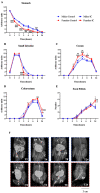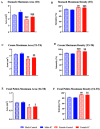Evaluation of the Effects of Instant Cascara Beverage on the Brain-Gut Axis of Healthy Male and Female Rats
- PMID: 38201895
- PMCID: PMC10780800
- DOI: 10.3390/nu16010065
Evaluation of the Effects of Instant Cascara Beverage on the Brain-Gut Axis of Healthy Male and Female Rats
Abstract
Instant cascara (IC) is a sustainable beverage obtained from dried coffee cherry pulp, rich in nutrients and bioactive compounds. The present research aimed to determine the effects of IC on general health and brain-gut axis parameters of healthy female and male rats. Wistar rats were exposed to IC (10 mg/mL) in their drinking water for 3 weeks. Body weight and solid and liquid intakes were monitored as indicators of food safety. Gastrointestinal transit was radiographically evaluated one day (acute) and 3 weeks (chronic) after the start of IC exposure. Locomotor activity, anxiety, and anhedonia of the animals after 3 weeks of treatment was also studied. Overall, compared to water-exposed animals, IC significantly increased food intake in males (p < 0.0001) and liquid intake in females (p < 0.05) without changes in body weight in either case. IC did not significantly modify gastrointestinal motility parameters after its acute or repeated intake and did not cause any significant behavioral alterations in males or females (p > 0.05). In conclusion, repeated intake of IC at the studied concentration did not negatively affect brain-gut axis functions of healthy male and female rats. Anxiety behavior, diarrhea, constipation, abnormal weight modifications, or other typical effects of toxicity were not observed in animals treated with the new powdered beverage, suggesting its food safety under the studied conditions.
Keywords: behavior; brain-gut axis; dried coffee cherry pulp; gastrointestinal motility; instant cascara; radiographic methods; rat; sex.
Conflict of interest statement
The authors declare no conflicts of interest.
Figures






Similar articles
-
Ex Vivo Study of Colon Health, Contractility and Innervation in Male and Female Rats after Regular Exposure to Instant Cascara Beverage.Foods. 2024 Aug 6;13(16):2474. doi: 10.3390/foods13162474. Foods. 2024. PMID: 39200401 Free PMC article.
-
The Impact of the Drying Process on the Antioxidant and Anti-Inflammatory Potential of Dried Ripe Coffee Cherry Pulp Soluble Powder.Foods. 2024 Apr 5;13(7):1114. doi: 10.3390/foods13071114. Foods. 2024. PMID: 38611418 Free PMC article.
-
Assessment of Healthy and Harmful Maillard Reaction Products in a Novel Coffee Cascara Beverage: Melanoidins and Acrylamide.Foods. 2020 May 12;9(5):620. doi: 10.3390/foods9050620. Foods. 2020. PMID: 32408584 Free PMC article.
-
Total allowable concentrations of monomeric inorganic aluminum and hydrated aluminum silicates in drinking water.Crit Rev Toxicol. 2012 May;42(5):358-442. doi: 10.3109/10408444.2012.674101. Crit Rev Toxicol. 2012. PMID: 22512666 Review.
-
Effects of Coffee and Its Components on the Gastrointestinal Tract and the Brain-Gut Axis.Nutrients. 2020 Dec 29;13(1):88. doi: 10.3390/nu13010088. Nutrients. 2020. PMID: 33383958 Free PMC article. Review.
Cited by
-
Glucose Homeostasis Improvement After Single Anastomosis Duodenojejunal Bypass with Sleeve Gastrectomy in Goto-Kakizaki Rats.Obes Surg. 2025 May;35(5):1620-1629. doi: 10.1007/s11695-025-07799-4. Epub 2025 Mar 25. Obes Surg. 2025. PMID: 40128514 Free PMC article.
-
Ex Vivo Study of Colon Health, Contractility and Innervation in Male and Female Rats after Regular Exposure to Instant Cascara Beverage.Foods. 2024 Aug 6;13(16):2474. doi: 10.3390/foods13162474. Foods. 2024. PMID: 39200401 Free PMC article.
-
The Impact of the Drying Process on the Antioxidant and Anti-Inflammatory Potential of Dried Ripe Coffee Cherry Pulp Soluble Powder.Foods. 2024 Apr 5;13(7):1114. doi: 10.3390/foods13071114. Foods. 2024. PMID: 38611418 Free PMC article.
References
-
- International Coffee Organization—Developing a Sustainable Coffee Economy. [(accessed on 29 March 2022)]. Available online: https://www.ico.org/sustaindev_e.asp.
-
- Technical Report on the Notification of Cherry Pulp from Coffea Arabica L. and Coffea Canephora Pierre Ex A. Froehner as a Traditional Food from a Third Country Following Article 14 of Regulation (EU) 2015/2283. Volume 18. EFSA Supporting Publications; Parma, Italy: 2021. EFSA-Q-2021-00004. - DOI
MeSH terms
Grants and funding
LinkOut - more resources
Full Text Sources

